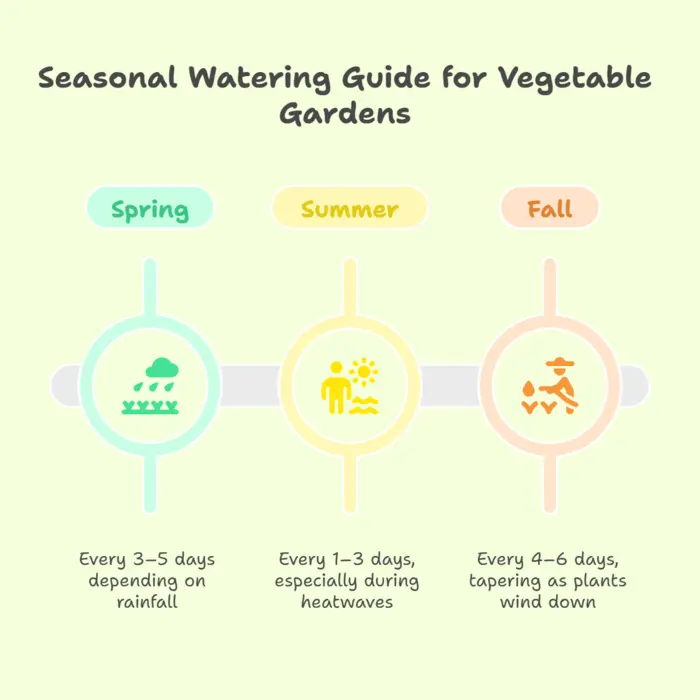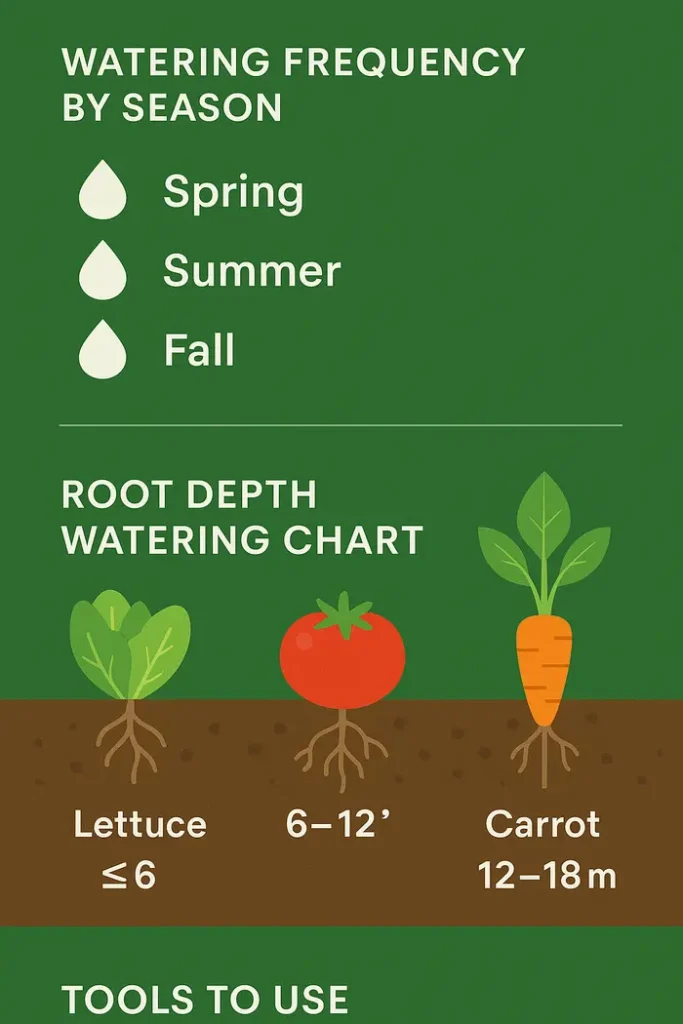How Often to Water Vegetable Garden: Smart Tips for Every Climate
Watering your vegetable garden might seem simple, but it’s easy to get wrong. Too much water can lead to root rot and plant stress, while too little can slow growth and reduce harvests. So, how often should you water your vegetable garden? The answer depends on your climate, soil, plant types, and even the tools you use.
In this post, we’ll break it all down, how often to water, how much water your veggies need, when to do it, and how to use smart tools and techniques to keep your garden healthy all season long.
How Often Should You Water a Vegetable Garden?
Let’s start with the basics. Most vegetable gardens need about 1 to 1.5 inches of water per week, from rainfall, irrigation, or both. But here’s the catch: that number isn’t one-size-fits-all.
Factors That Affect Watering Frequency
- Season: In spring and fall, you might water less frequently. During hot summer months, you’ll likely need to water more often.
- Soil Type: Sandy soils dry out faster and need more frequent watering. Clay soils retain moisture longer.
- Plant Maturity: Seedlings need more frequent, gentle watering. Mature plants can handle deeper, less frequent soakings.
- Weather Conditions: Wind, heat, and sun exposure all increase evaporation, requiring more watering.
General Watering Schedule
- Spring: Every 3–5 days depending on rainfall
- Summer: Every 1–3 days, especially during heatwaves
- Fall: Every 4–6 days, tapering as plants wind down
Tip: Check the soil 2–3 inches below the surface. If it’s dry, it’s time to water.

How Much Water Do Vegetables Need?
Now that we’ve covered frequency, let’s talk about quantity. Most veggies thrive when they receive about an inch of water per week. But some crops need more.
Vegetable Watering by Root Depth
| Vegetable | Root Depth | Watering Style |
| Lettuce | Shallow (6-12″) | Light, frequent |
| Tomatoes | Deep (24-36″) | Deep, infrequent |
| Carrots | Medium (12-18″) | Moderate soak |
| Peppers | Deep (18-24″) | Consistent, deep |
The Mulch Advantage
Adding organic mulch like straw, leaves, or compost around your plants can reduce watering needs by keeping moisture in the soil. It also prevents splash-up, which helps avoid foliar diseases’.
Best Time of Day to Water Vegetables
How often to water vegetable garden? Well, morning is the best time to water. Here’s why:
- Less evaporation: The cooler air helps water soak into the soil.
- Healthier leaves: Leaves dry quickly, reducing the chance of fungal problems.
- Boosts plant performance: Plants absorb water before the heat of the day.
Avoid watering late in the evening. Damp leaves overnight can attract diseases.
Smart Tools for Efficient Watering
Using the right tools can save time, water, and improve your harvest. Here are some worth trying:
1. Soil Moisture Meters
A simple meter tells you if your soil is actually dry—or just looks that way. These tools help you avoid overwatering.
2. Soaker Hoses and Drip Irrigation
These systems slowly deliver water right to the root zone, reducing waste and runoff. Soaker hoses are ideal for rows, while drip systems work great for raised beds or containers.
3. Rain Gauges
Keep one in your garden to measure how much water your plants are getting from nature. If you get an inch of rain, skip watering that week.
4. Smart Irrigation Systems
Bluetooth-enabled tools like PlantLink or Koubachi monitor soil moisture and can automatically adjust watering schedules. These systems use climate data and are perfect for busy gardeners.
Soil Type Matters More Than You Think
Your garden’s soil can make or break your watering plan. Here’s a quick breakdown:
- Sandy Soil: Drains quickly; needs more frequent watering.
- Clay Soil: Holds water longer; water less often but deeply.
- Loamy Soil: The gold standard, holds moisture but drains well.
Test your soil: Squeeze a handful of damp soil. Sandy soil crumbles, clay sticks together, and loam holds its shape but breaks apart easily.
How to Spot Overwatering and Underwatering
Learning the signs can save your plants:
Overwatering Signs
- Yellowing leaves
- Wilting despite moist soil
- Root rot smell
- Mold or algae on the surface
Underwatering Signs
- Dry, brittle leaves
- Slow growth
- Leaf curl
- Soil pulling away from edges of the container
If you’re unsure, dig a small hole 4–6 inches deep and check the soil moisture. Also, check this quick read for more info. If it’s dry at that level, it’s time to water.
Water-Saving Hacks for Vegetable Gardens
Gardening smarter, not harder, can help you save water and still grow great veggies.
Use Mulch Generously
A 2–3 inch layer of mulch can reduce water needs by up to 50%.
Plant Smart
Group plants with similar water needs together. This avoids overwatering some while underwatering others.
Collect Rainwater
Use rain barrels to collect and reuse natural water. It’s free and sustainable.
Set Timers
Whether it’s a basic hose timer or a smart app-controlled system, timers prevent overwatering and let you water consistently.
Drought-Resistant Vegetables to Try
Want to garden in dry conditions? Try these resilient crops:
- Okra
- Zucchini
- Swiss chard
- Cherry tomatoes
- Eggplant
- Pole beans
These vegetables need less water and tolerate heat well. Pair them with mulch and smart watering for best results.
Climate-Adaptive Watering: The Future
With unpredictable weather patterns becoming more common, it helps to use tools and strategies that adapt.
Use Climate Data
Check NASA or NOAA data for rainfall trends and temperature shifts in your area. Adjust your watering schedule accordingly.
Try Xeriscaping Principles
Though usually used in landscaping, xeriscaping (low-water gardening) can apply to veggie gardens too. It’s all about using drought-tolerant plants, improving soil, and designing efficient layouts.
Let Tech Help You
AI-based apps and Bluetooth soil sensors are changing the way we water. These tools monitor real-time conditions and adjust schedules based on soil moisture, temperature, and rainfall.
Final Thoughts: How Often to Water a Vegetable Garden
So, how often should you water a vegetable garden? The answer isn’t a one-size-fits-all number. It depends on your soil, weather, crops, and tools. But with a little observation and the right systems in place, you’ll find a rhythm that keeps your veggies happy and healthy.
Don’t be afraid to experiment and adjust. Use a soil moisture meter, pay attention to plant signals, and take advantage of climate-adaptive tools. Your garden and your harvest will thank you.
FAQs
Q: Can I water my vegetable garden at night?
A: It’s not ideal. Watering at night can lead to leaf diseases due to prolonged moisture. Morning is best.
Q: Is it okay to water vegetables every day?
A: Only in extreme heat or if you have sandy soil. Otherwise, deep watering a few times a week is better.
Q: How do I know if my soil is dry enough to water?
A: Stick your finger or a moisture meter about 2–3 inches into the soil. If it’s dry, go ahead and water.







